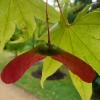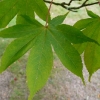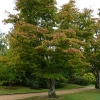Features
Grown as a tree or shrub this will suit most sized gardens and provide a fantastic display of autumn colour.
The leaves are paired, with 7 pointed, deep lobes and sharply toothed margins. They are green, turning brilliant scarlet in autumn. Buds are ovoid in shape, 2 to 3cm long and reddish in colour. In April/May small dark purple/red flowers appear in clusters on red stalks. It then bears scarlet red, winged fruits (“samaras“) in summer and autumn which hang in clusters.
What to use it for
A good tree for a small to medium size garden which can provide shade in the summer before its glorious autumn display. It suits most styles of garden, is low maintenance and can be an interesting focal point. It also copes well with being grown in containers and could be a suitable feature for a large rock garden.
How to look after it
Ensure that it is watered in drought conditions, particularly in the first few years of growth.
How to prune it
While establishing an Acer Palmatum the plant should be staked to provide it with additional support and pruned to remove any badly placed or crossing stems. Once established pruning should be kept to the bare minimum – only removing dead, damaged, diseased and crossing stems.
Any pruning should be done in winter when the tree is completely dormant. If done at any other time the plant will ‘bleed’ sap and be weakened as a result. Minor pruning of thin stems could be undertaken in late summer or early autumn if necessary.
How to propagate it
Propagate by softwood cuttings in mid-spring (you may need to bring the parent plant under cover to get it to put on enough growth to take the cutting this early) or early summer. Alternatively carry out simple layering in mid/late autumn or early spring.
If you have the skill, grafting can be done in late winter or summer (using a side veneer graft so the scion is not pushed off by the rising sap). However, this cultivar is quite vigorous, so you should have success propagating by cuttings or layering instead.
Common problems
Leaf scorch due to a lack of soil moisture or too much exposure to the elements (eg intense sunlight, high winds).
Aphids and horse chestnut scale can be a problem, as can verticillium wilt.
Other useful information
The ‘palmatum’ species of acers are so named since their lobed leaves resemble outstretched hands, ie ‘palms’. Ōsakazuki means ‘I love Osaka’ in Japanese Ōsaka being Japan’s second largest city.
Has been given the Award of Garden Merit by the Royal Horticultural Society.









